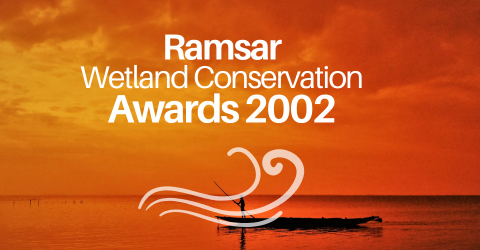
Prix 2 2002

The Chilika Development Authority (Inde)
(Commission du développement de Chilika)
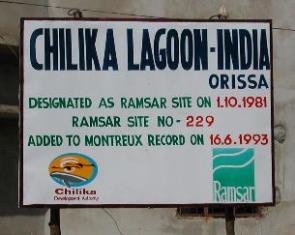
The Chilika Development Authority (CDA) receives the Ramsar Award for its impressive work and outstanding achievements in restoring the Chilika Lake Ramsar Site. This restoration has been carried out based on the principles of wise use and integrated management, and with a major emphasis on the participation of the local population and their shared decision-making, as well as capacity building. Chilika Lake is a striking example of how restoration of the ecological characteristics of a site can result not only in increased biodiversity (plant and animal species, notably birds), but also in a spectacular increase in fish catches (including the reappearance of some economic species) and other socio-economic benefits to the local population.
Chilika Lake (Orissa, India), the largest lagoon on the east coast of India, was added to the Ramsar List of Wetlands of International Importance in 1981. It is a 116,500 hectare brackish lagoon separated from the Bay of Bengal by a long sandy ridge. Because of serious degradation brought about mainly by siltation and choking of the seawater inlet channel, resulting inter alia in the proliferation of invasive freshwater species, the decrease in fish productivity, and an overall loss of biodiversity, Chilika Lake was added to the List of Ramsar sites in danger (the Montreux Record) in 1993. In addition to its importance for waterbirds (over one million migratory birds winter there) and biodiversity in general, significant numbers of people are dependent upon the lake's resources.
Created in 1992 to address these problems, the Chilika Development Authority has implemented a bold programme of action to restore the ecosystem and to improve the socio-economic conditions of the communities living around the lagoon and on its islands. One of the major interventions was the desiltation of the channel connecting the lagoon to the sea and opening of a new mouth to restore the natural flows of water and salinity levels. This resulted notably, in only a couple of years, in a substantial increase in the lagoon's fish yield and a reduction of freshwater weeds. Other measures include catchment management in a participatory manner; protection of bird habitat and of bird species; economic incentives to the local population to stop poaching of birds; measures to improve the socio-economic conditions, such as training programmes to develop eco-tourism, provision of solar streetlight systems to island villages, development of a ferry service for isolated villages, construction of landing facilities for fisherfolk, as well as education and environmental awareness activities.
The above-mentioned activities were carried out based on the scientific studies and recommendations of the premier institutes of the country, with the involvement of the local population and the support of Wetlands International and local NGOs, as well as grass-root and community-based organisations, under the guidance of the CDA Chief Executive Officer, Ajit Pattnaik, a native of the region who devoted himself wholeheartedly to the task. The restoration of Chilika lagoon derives its uniqueness from the strong participation by local communities, linkage with various national and international institutions, and intensive monitoring and assessment systems. In 2001, a Ramsar Advisory Mission was carried out at the Chilika Lake Ramsar site, which concluded with the recommendation that the site should be removed from the Montreux Record, provided that the management measures are continued and monitored. The case of Chilika Lake is a perfect example of how the listing of a site on the Montreux Record can be used to promote measures to correct change in ecological character of a site, and also to improve the socio-economic conditions of the population living in and around the site.
The Ramsar Award is being given to the Chilika Development Authority in recognition of the exemplary restoration work carried out with the active involvement of all stakeholders.
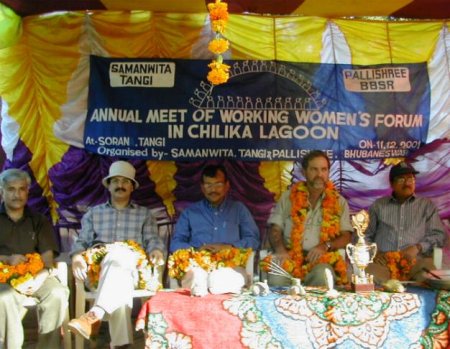
From left: Chaman Trisal, Wetlands International, South Asia Programme; Najam Khurshid, Ramsar Bureau; A. J. Pattnaik, Chilika Development Authority; Max Finlayson, Ramsar expert consultant; Sidharth Kaul, Ministry of Environment and Forests, on the occasion of the Ramsar Advisory Mission to Chilika Lake, 2001.
---An Interview with the Chief Executive Officer, CDA---
Coordinated by Freshwater and Wetlands Conservation Programme, WWF-India, New Delhi, India
Chilika, the largest brackish water lagoon along the east coast of India, is a hotspot of biodiversity with a unique assemblage of fresh water, brackish and marine ecosystems. However, not so long ago, the very existence of this unique lagoon ecosystem was threatened with serious degradation. The Chilika Development Authority (CDA), under the guidance of Ajit Pattnaik, Chief Executive Officer, took upon itself the task to revive this dying lagoon. The efforts have born fruit. CDA has been chosen for the prestigious Ramsar Award (2002) for its impressive work and outstanding achievement in restoring the Chilika Lake, a Ramsar Site.
Here Sumeet Kaur, Communications Officer, World Wide Fund For Nature- India talks to Mr. Pattnaik on the efforts that went into reviving Chilika's pristine glory as a haven of biodiversity.
What does this achievement signify for the CDA?
The Ramsar Wetland Award came as a pleasant surprise for CDA. I consider it as a deep acknowledgement of the dedicated work by the CDA team with the active support of the community of Chilika. This is a great source of inspiration for the future endeavor of CDA for the sustainable management of the lagoon.
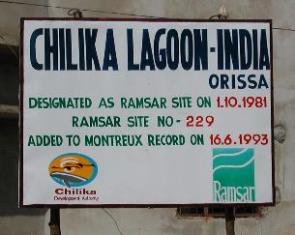
How important is the Chilika Lagoon with respect to the Convention on Wetlands?
Chilika lagoon located along the east coast of India is one of the first eight Ramsar sites of India. This nutrient rich estuarine shallow lagoon, in combination with spatial and temporal variations in salinity is bestowed with vast and varied resources and is highly productive. It is a unique ecosystem and a hotspot of biodiversity. Some rare, vulnerable and endangered species listed in the IUCN Red List of threatened animals inhabit the lagoon for at least a part of their life cycle. A survey of the fauna of Chilika lagoon carried out by the Zoological Survey of India in 1985-87 recorded over 800 animal species, including the Irrawady dolphin. It is an avian grandeur and wintering ground for more than one million migratory birds, some of which are rare and endangered. Most importantly, the highly productive eco-system of the lagoon with its rich fishery resources sustains the livelihoods of more than 0.20 million community locals who live in and around the lagoon. On the banks of the lagoon lie 8 large towns and 122 villages. About 70 percent of this population depends upon fishery resource of this lagoon for their livelihood. Based on its rich biodiversity and socioeconomic importance, Chilika lagoon was designated rightly as a Ramsar site in 1981.
Give us a brief background on the emergence of the CDA. (When, where and how was it formed)?
The Chilika had been encountering the problems of siltation, chocking of the inlet as well as the outlet channel connecting the sea, progressive shifting of the mouth (opening to the Sea) away from the lagoon, and consequent decrease in salinity gradient, weed infestation, shrinkage of water spread, depletion of the fishery resources and water logging in the peripheral agricultural lands. This had an adverse impact on its biodiversity and an overall decline in the productivity affecting the livelihood of the community dependent on it. Perceiving the threat to this unique wetland ecosystem, Government of Orissa created Chilika Development Authority in 1992 with the Chief Minister as its Chairman. The CDA was created as an organization exclusively dedicated for restoration and conservation of the lagoon resources with community participation.
Chilika has come a long way, from being added to the Montreux Record to receiving Ramsar Wetland Conservation Award. Could you elaborate on Chilika's journey from a once threatened site to now an award winning one?
The Chilika Development Authority was created at a very crucial time when the lagoon ecosystem was in peril. Chilika was placed in the Montreux Record in the year 1993 because of changes in its ecological character. The community had lost their hope of any turn around situation of the lagoon, as the catch from the lagoon was hardly enough to sustain their family. Without finding any alternatives, they were migrating to the cities in search of employment. The salinity level of the lagoon was observed to be decreasing alarmingly due to the choking of the inlet/outlet channels opening to the sea. The Zoological Survey of India (ZSI), based on their extensive survey of the lagoon carried out for three years from 1985-1987,reported that the lagoon was transforming towards a fresh water ecosystem, which would endanger the flora/fauna of the lagoon. CDA commissioned the services of pioneer institutes of the country to trace the root cause of the problem through extensive studies and to explore the best options to restore its ecosystem. The National Institute of Oceanography (NIO), Goa was invited to do a detailed study of the wave climate of the Chilika mouth, littoral drift, sedimentation and the bathymetry of the outer channel of the Chilika as well as the environmental monitoring of the lagoon and also to assess the probable impact of desiltation on the lagoon ecosystem. The Central Water and Power Research Station (CWPRS), Pune, carried out the hydrological and two dimensional mathematical model studies. The studies concluded that the tidal influx into the lagoon was considerably reduced because of the shoal formation along the lead channel and continuous shifting of the mouth, which resulted in significant hydraulic head loss.
As you know, wetlands pass through a cyclic process and the lagoon ecosystem is very dynamic and polycyclic. Therefore, before any intervention, the holistic analysis of the problems and issues is essential for a clear understanding of the problem and most appropriate solution for it. The model studies were carried out with an objective to achieve the optimum salinity regime and accordingly the boundary conditions were fixed. Based on the findings, the CWPRS recommended for the opening of a new mouth. This huge task involved a number of critical tasks e.g. liaison with various National and International institutions, Government Departments and experts. A critical intervention like this needs the full backing and acceptance of the community and this was accomplished by way of wide consultations with community, NGOs, and other community-based organizations. So after a thorough analysis and the deliberation the major intervention by way of opening of a new mouth was carried out, which is considered as historic in the restoration ecology. EIA was carried out by NIO, Goa before deciding on any intervention to correct the situation. Rigorous monitoring to assess the impacts of the interventions followed this. The impact of the hydrological intervention was encouraging which resulted in restoration of salinity regime, improvement of the tidal flux, turning the lagoon into pulsing mode, phenomenal improvement in the fish, crab and prawn landing, reappearance of a number of economic species, improvement in the water quality, decrease of the fresh water invasive species, etc. The hydrological intervention not only rejuvenated the ecosystem of the lagoon but also immensely benefited the dependent community whose average annual income increased by more than Rs. 50,000 per annum (US$ 1040 approx.) per family.
The other measures taken by CDA include the participatory management of the western catchment on a micro watershed basis, restoration of Nalabana Bird Sanctuary and improvement of bird habitats with the active participation of the community. Awareness campaign and environmental education, development of a visitor center, improvement of communication networks and a research center on wetland management are other noteworthy developments. The holistic and integrated approach adopted by CDA for restoration of the lagoon is a unique example of restoration ecology. The Ramsar Advisory Mission based on their assessment of the steps taken by the CDA had recommended for removal of Chilika from the Montreux record. Indeed, this is a long journey, from Montreux record to the prestigious Ramsar Wetland Award.
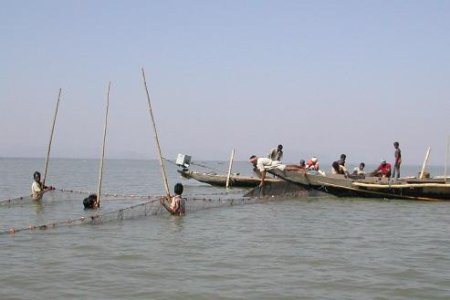
What has been the most challenging task for CDA in its restoration work?
The restoration model of Chilika involved two key issues, one to restore the complex lagoon ecosystem and the other to ensure and safeguard the conflicting interests of the local community who depend on the lagoon. Following the recommendations of the CWPRS, an artificial mouth was to be opened and this was one of the most important components of the restoration work. This was a very difficult task, both in terms of the difficulty in taking a decision on an intervention with such far-reaching consequences and to accomplish this from both intervention point of view as well as winning people's acceptance to it. The involvement of the community in decision making and formulation of strategy in a consultative way has won the cooperation of people for such major intervention that took considerable time though.
What according to you has been the most significant outcome of your efforts?
The re-establishment of the connection between the lagoon and the sea through the desiltation of the outer-channel and opening of an artificial mouth along the sand spit at a distance of 11 kilometers from the lagoon proper is considered as most successful hydrological intervention to restore the eco-system of the lagoon. This has ameliorated the lagoon ecosystem and at the same time significantly contributed towards the increase in the per capita income of the communities that depend on the lagoon for their livelihood. The increase in the productivity level in both the wetland as well as the watershed due to the good environmental practices has facilitated the poverty alleviation of the community. The increase in the fishery resources facilitated the community to adopt self-initiated good practices, like regulation of the mesh size, refraining from the juvenile poaching, etc. It is also paving the way for CDA for an effective channel of communication through consultation with communities who depend on the lagoon resources and to adopt the co-management strategies for wise use of the lagoon resources.
Could you throw some light on the principles and mission governing the working of CDA?
As I have already mentioned CDA is a compact organisation. The strength of the CDA is a dedicated, close-knit and zealous team. The commitment and support of the State and Union Government is the major driving force behind the successful implementation of the restoration work. Governing body of CDA is headed by Chief Minister, which itself is the indication of the commitment of the State Government. CDA worked in close liaison with a number of organizations as well as institutions, both inside and outside the country with active support of the local community. A systematic monitoring and assessment system to assess the impact of the various interventions is one of the key elements in the restoration programme.
What role has networking with other agencies played in your effort of restoration?
I must admit here that the mammoth task of restoration could only be accomplished because of the networking with a number of national as well as international institutions, community based organizations, local NGOs, self help groups and the local communities. The Wetlands International South Asia had been a partner of CDA from the very beginning in this effort. In addition to this, the contribution of CWPRS, Pune; NIO, Goa; Ocean Engineering Center, Indian Institute of Technology (Madras), Chennai is also significant in the restoration effort.
How will this award benefit CDA in particular and other wetland sites in general?
The award is a great source of inspiration for CDA as well as all the partner organizations and the communities in particular who worked hard to achieve this success. It will encourage developing long-term strategies to sustain this effort.
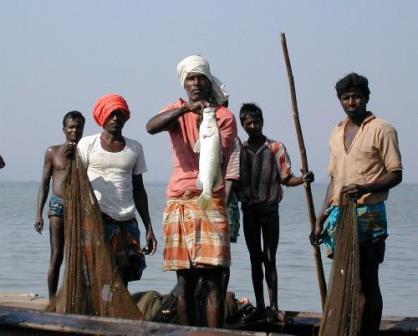
What do you attribute your success to?
The community participation, linkage with the various national and international institutions, intensive monitoring and assessment system are some of the unique aspects of the management practices adopted by CDA for achieving this success.
What are your plans for the future?
The hydrological interventions for the restoration of the lagoon have resulted in considerable improvement of its fishery resources, water quality, and a positive impact on the biodiversity of the lagoon. This has significantly contributed towards the increase in the per capita income of the communities that depend on the lagoon for their livelihood. The increase in the productivity level in both the wetland as well as the watershed due to the good environmental practices facilitated the poverty alleviation of the communities. At the same time, time is now ripe to start a process to establish a participatory and a self-sustainable mechanism for conservation and wise use of the resources of the Chilika lagoon. CDA will now focus on the long-term strategy to sustain the good practices adopted by the community and facilitate the wise use of the lagoon resources by the community to achieve this. CDA is also planning to promote the community-based eco-tourism with the award money, which will provide an alternate source of income for the communities.
Interview Concluded